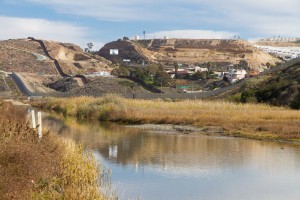Friendship Park, San Diego, California – that’s about as close as I’ve ever gotten to Mexico despite having spent the past three years of my life in the United States. During a recent visit to the west coast, my friends were intrigued by my choice of tourist attractions to visit in Southern California. ‘Why are we driving out here to see a fenced up border rather than enjoying the sights of downtown San Diego?’ This questioned probably lingered on their minds as we hiked under the hot sun from the parking space towards the border.

Borders, as suggested by its definition, are boundaries that divide. When I read stories about how friendship park provided a platform for families divided by the border to come into contact with each other, I knew I had to see it with my own eyes and be immersed in the subtle joys of temporary unification. And there it was – families engaged in hearty conversations, children running around playing catch, and border control officers explaining the significance of friendship park with a smile on their face. Interestingly, the only imagery I had of the US-Mexico border prior to this came from the the Fast & Furious franchise, where Vin Diesel and his troopers regularly make multiple undercover trips to move in and out of Mexico. It suffices to say that I came away that day with a vastly different impression of this border.


Growing up, I’ve always been drawn towards understanding cultures that I considered to be ‘exotic’, cultures that were vastly different from the one I grew up in; Latin America was no exception. In particular, Mexico was a country that I was fascinated by. Despite being a close geographical neighbor of the United States, Mexico is characterized by a vastly differently culture, history, economy and people. Amongst others, this was a key motivation for me to participate in this travel class.
The excitement of travel and exploration aside, the pre-course readings and discussions have also got me mulling over issues in conservation biology, an area of science and policy that I have grown to deeply appreciate over the past decade. Although a wide array of topics were covered, three of them stood out most significantly to me.
First, I was greatly surprised by the contribution of small-scale fisheries in terms of its global economic output as well as its influence on food security in many parts of the world. Having grown up in a developed country, seafood to me was basically a commodity that could be purchased in supermarkets. Fresh fish, mollusks, and crustaceans are simply laid out on a nice bed of ice, ready to be picked up by customers. I never once thought about where the seafood I was consuming came from and knew little about how the fishery industry was broken down into various subsectors (i.e. commercial, small scale, artisanal etc.). The paper by Daniel Pauly provided a great visualization of how important small scale fisheries are despite their marginalization. While supplying similar amounts of annual catch as commercial fisheries, small scale fisheries provide economic opportunities to more individuals, have a significantly smaller carbon footprint, and produce significantly less by catch. Clearly, this industry deserves more attention than it gets and we have ways to go in understanding its nuances and in developing appropriate measures for its management.
Second, readings about various strategies in conservation flung me into an internal debate on the best way forward for protecting biodiversity. It seemed like the conservation community was generally divided into two big schools of thought – one that champions a ‘fortress conservation’ approach, where natural areas were essentially fenced up and people excluded for its protection, versus another that champions a community based approach that allowed people to remain in protected natural areas and encouraged their participation in the management of conservation resources. Personally, I do not think that there is a one-size-fits-all model to biodiversity conservation and the application of either school of thought depends strongly both on the ecological and social context of the natural areas being protected. In that regard, decisions are likely to rest on the assumptions that people make about the communities living in those natural areas. Different approaches are likely to be favored depending on whether the underlying narrative paints people as exploiters or as stewards of natural resources.
Thirdly, an intrinsic challenge seems to exist in biodiversity conservation. On one hand, it is necessary to empower conservation organizations to enable them to bring about change but on the other, when too much authority is given to these organizations, insufficient checks and balances are put into place to ensure that the authority is not abused. Mac Chapin’s article highlights this very problem that exists across the three big international non-governmental organizations (BINGOs) – The World Wildlife Fund (WWF), Conservation International and The Nature Conservancy. This begs the question – how can BINGOs be made accountable for their actions without hampering their progress in global conservation efforts? The international nature of these organizations poses a challenge as national authorities may no longer be sufficient to ‘govern’ them.
At this juncture, I look forward to exploring these issues at a deeper level during the course. I am excited to be situated at the Sea of Cortez and to be understanding issues that small scale fisheries face from the perspective of the fisherfolk themselves. I hope that our engagement with them will provide the necessary insights to answer some of the deep seated questions of conservation biology and fisheries management. Here’s to a fruitful trip!

Really enjoyed your thoughtful discussion, Donovan! Hope you’ll do a follow-up posting after the travel class returns to Beaufort.